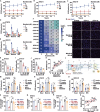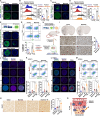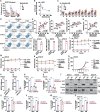Exploiting metabolic vulnerability in glioblastoma using a brain-penetrant drug with a safe profile
- PMID: 39901019
- PMCID: PMC11903783
- DOI: 10.1038/s44321-025-00195-6
Exploiting metabolic vulnerability in glioblastoma using a brain-penetrant drug with a safe profile
Abstract
Glioblastoma is one of the most treatment-resistant and lethal cancers, with a subset of self-renewing brain tumour stem cells (BTSCs), driving therapy resistance and relapse. Here, we report that mubritinib effectively impairs BTSC stemness and growth. Mechanistically, bioenergetic assays and rescue experiments showed that mubritinib targets complex I of the electron transport chain, thereby impairing BTSC self-renewal and proliferation. Gene expression profiling and Western blot analysis revealed that mubritinib disrupts the AMPK/p27Kip1 pathway, leading to cell-cycle impairment. By employing in vivo pharmacokinetic assays, we established that mubritinib crosses the blood-brain barrier. Using preclinical patient-derived and syngeneic models, we demonstrated that mubritinib delays glioblastoma progression and extends animal survival. Moreover, combining mubritinib with radiotherapy or chemotherapy offers survival advantage to animals. Notably, we showed that mubritinib alleviates hypoxia, thereby enhancing ROS generation, DNA damage, and apoptosis in tumours when combined with radiotherapy. Encouragingly, toxicological and behavioural studies revealed that mubritinib is well tolerated and spares normal cells. Our findings underscore the promising therapeutic potential of mubritinib, warranting its further exploration in clinic for glioblastoma therapy.
Keywords: Hypoxia; Metabolic Reliance; Oxidative Phosphorylation; Radiotherapy; Reactive Oxygen Species.
© 2025. The Author(s).
Conflict of interest statement
Disclosure and competing interests statement. The authors declare no competing interests.
Figures













References
-
- Alexander BM, Ba S, Berger MS, Berry DA, Cavenee WK, Chang SM, Cloughesy TF, Jiang T, Khasraw M, Li W et al (2018) Adaptive Global Innovative Learning Environment for Glioblastoma: GBM AGILE. Clin Cancer Res 24:737–743 - PubMed
-
- Alistar A, Morris BB, Desnoyer R, Klepin HD, Hosseinzadeh K, Clark C, Cameron A, Leyendecker J, D’Agostino Jr. R, Topaloglu U et al (2017) Safety and tolerability of the first-in-class agent CPI-613 in combination with modified FOLFIRINOX in patients with metastatic pancreatic cancer: a single-centre, open-label, dose-escalation, phase 1 trial. Lancet Oncol 18:770–778 - PMC - PubMed
-
- Baccelli I, Gareau Y, Lehnertz B, Gingras S, Spinella JF, Corneau S, Mayotte N, Girard S, Frechette M, Blouin-Chagnon V et al (2019) Mubritinib targets the electron transport chain complex I and reveals the landscape of OXPHOS dependency in acute myeloid leukemia. Cancer cell 36:84–99.e88 - PubMed
MeSH terms
Substances
Grants and funding
LinkOut - more resources
Full Text Sources
Medical
Miscellaneous

